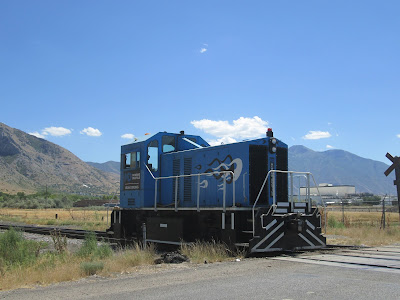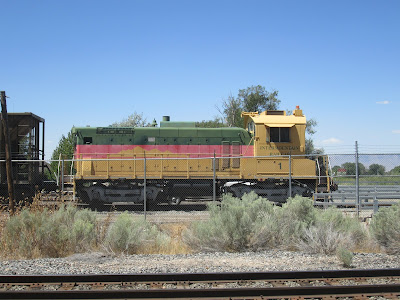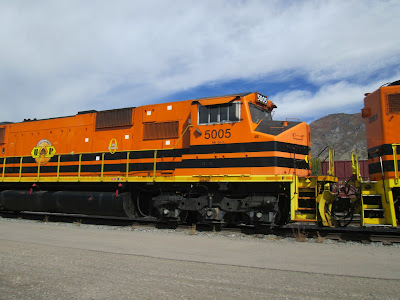One of the most intriguing aspects of railfanning in my opinion is the work done by industrial switchers. Many industries and shortlines use engines that have exchanged ownership several times, and have worked a long life. Compared to the high horse power units used on the mainline, these units might not seem like much. Their rarity makes them far more unique than the common mass produced locomtives plowing the rails of a Class 1 railroad. Utah has a few weird engine classes at work in industries, shortlines, and even at our tourist railroad in Heber. This is not a comprehensive list, but a small sample of a few of the oddballs that are out there. Some of these locomotives are so rare, you can't find models of them in any hobby shop! I've already talked about the unique high cab GP39-2 units used by Kennecott in this previous post.
Baldwin-Hamilton RS-4-TC. Locations: Heber Valley Railway; Heber, Utah. Peterson Industrial Depot; Tooele, Utah. Broken Arrow; Grantsville, Utah.
The RS-4-TC was a switch locomotive built for the military. Only 74 were produced, and most were kept in long term storage; in the event the U.S. military needed them to conduct railroad operations over hostile fronts. When it became clear that capturing enemy railroads was no longer a necessary tactic in the 20th century, these units finally began to earn their keep at military bases, until they were sold as surplus to the private sector. Despite being a relatively obscure locomotive class, five of these engines are currently in Utah. Four of them are based in the Tooele County. The fifth is in service on the Heber Valley Railroad.
PID 1250 came to Tooele along with its sister locomotive PID 1258. The two engines were previously located at the clean up site of the uranium tailings in Moab. The two were bought together, and brought up to Tooele. When PID 1250 arrived in Tooele, it had the nickname "Captain Jack" stenciled onto the side. Names such as that sure give these locomotives a more 'human' factor.
Although the current paint scheme omits the "Captain Jack" name, PID 1250 is still known among railfans by that name. Here we see "Captain Jack" switching some cars at the eastern borders of the industrial depot.
Two RS-4-TC's are located on the opposite side of the Tooele Valley near Grantsville at the Broken Arrow salt processing facility. Numbered BCS 242, and BCS 243; I had the opportunity to take a cab ride in one of these engines nearly five years ago.
Heber Valley 4028, wears a dashing Rio Grande inspired paint scheme. The Heber Valley runs on what was once a DRGW branchline; so it is only fitting that at least some of their locomotives wear the Grande's paint. Despite being one of the smallest locomotives at Heber, it seems this engine has been nicknamed by the crew with the name "Big Boy." Surely an ironic name for such a small engine!
The RS-4-TC's were built small enough to run through the small tunnels and platforms of Britain, in the event a war in Europe demanded that the Americans needed to send additional locomotives to the UK. The height difference can be observed when 4028 is compared to some of the other locomotives at Heber, such as the GP unit in the background.
Of the five RS-4-TC units in Utah; PID 1258 has been the least fortunate. Like PID 1250, it came to Utah to work at the tailings clean up project in Moab. After its time there, it went with 1250 to Tooele to work at the Industrial Depot. PID 1258 had been given the name "Susan B. Anthony;" after the famed leader in the woman's suffrage movement. In October 2015, "Susan B." was involved in a major freight car collision which damaged several parts of the locomotive. Since then it has sat in storage at PID.
A close up inspection of the damages on "Susan B." (PID 1258) reveals just how bad the collision was.
Republic RX500 Switcher. Location: McWayne Ductile; Provo, Utah.
The RX500 as of now, is still a rather rare locomotive class. However, unlike many of the other engines in this post, the RX500 is still in production; so it is possible these little critters might someday dominate industrial switching across the U.S. As of now, Utah only has one RX500, working at McWayne Ductile in Provo, Utah. With it's clean blue paint, and flame decals (yes I said that right, flame decals) this engine is quite the sight for railfans who go and visit it.

Rather than try and explain what makes this engine unique, I'll let Republic Locomotive explain it themselves in this video they posted to YouTube. It will be interesting to see if this engine class becomes more common in the near future.
The MRS-1 locomotives were built for the military for the same reason the RS-4-TC locomotives were built. The military ordered the class from two different manufacturers, General Motor's EMD division, and ALCO. The EMD MRS-1 and ALCO MRS-1 have similar exteriors, but differ with internal components. Since they were built for possible use overseas, they were also built to fit the restricting clearance of places such as Britain.
One EMD MRS-1 (Heber 1813) has been preserved in Utah on the Heber Valley Railway. As of the time of this writing, 1813 is the line's primary road engine right now while Heber works on restoring their steam locomotives.
Labor Day 2016; the 1813 departs the Heber Yard with a long train on a Monday night special.
Labor Day 2015, the 1813 waiting at the head of a Monday night special at the station.
A close up view of the builder's plate of the 1813. Only a handful of EMD style MRS-1 units were built. Most of the MRS-1 class was represented by ALCO's. Despite this, five of the EMD units survived into preservation.
Rebuilt EMD GP10. Location: Chevron Refinery; Salt Lake City, Utah.
RSSX 436 is one of the hardest to catch engines in Utah. Despite being based at a refinery just north of Salt Lake City, this engine hardly shows its face in public for long (as evidenced by more poor photo of it.) The GP10 unit was the result of rebuild programs done by both the Illinois Central Railroad and Conrail. RSSX 436 was built during the Illinois Central program, and would later work on the Iowa Interstate Railroad before coming to Utah. Getting to catch this engine up close is a very special opportunity!
The B36-7 is one of GE's lesser known locomotive types. Popular on many eastern railroads such as Conrail, and the Seaboard System; only a handful of these units made it to western railroads; 16 to the Santa Fe, and 20 to the Southern Pacific and it's St. Louis Southwestern (Cotton Belt) subsidiary. PID 3611 started as one of those 16 units on the Santa Fe. The unit was later sold to BC Rail in Canada, were the air conditioning unit was removed, and the bell and headlights were modified to Canadian specs. 3611 came to Utah originally working for the Savage, Bingham and Garfield, the group contracted to run trains over the former DRGW Bingham and Garfield branches. Savage also owned another B36-7, and 3611 worked in tandem with that engine. Eventually Savage divested their two B36-7 units, and the 3611 came to Tooele.
The 3611 has had quite a long history, having worked originally on the Santa Fe railroad, then in British Columbia. It first came to Utah to work the "Midvale Tramp" for the Savage group. It was then sent to Tooele, where it became one of the three engines in service at the Peterson Industrial Depot. These photos show 3611 sometime after arrival in Tooele, with "Captain Jack" effectively photobombing the scene.
Once it was stripped of its blue paint, the 3611 took on a rather professional looking gray paint scheme, a stark contrast with the garish neon orange and green hues of its fellow engines at PID.
This close up view of the 3611 shows its high mounted bell on the cab, an artifact from the engine's days in Canada.
Rebuilt EMD GP16. Location: On military bases in Roy and Tooele. Scoular Grain Silo in Ogden, Utah.
Just like the GP10 featured earlier, these GP16 units are the result of a rebuild program that upgraded older GP units into a more modern type of unit. The GP16 was created by the Seaboard Coast Line Railroad by using parts from GP7, GP9, and GP18 units. Most of these units have been sold to industrial operators; and a handful have found their way into working with the Department of Defense.
USAX 4635 started life as a GP9; and ultimately found its way into service for the US Army. After many years of work at Fort Eustis, Virginia; it was last seen at work in Tooele at the army base there.
Scoular Grain near Ogden has a lone GP16 as their switching locomotive.
EMD/Clyde Engineering SD50S. Location: Used throughout the Utah Railway system.
Acquired by the Utah Railway in 2001; these five SD50S units are natives of Australia. Built by Clyde Engineering on behalf of EMD; these five units worked iron ore trains on the Hamersley & Robe River Railway in western Australia. These units have a shorter length than their American built SD50 cousins, have a double insulated roof to protect against the desert heat in Australia, and have horns mounted on the side of the long hood instead of on top. Now on the Utah Railway, a sharp eye can spot the Aussie heritage on these units.
EMD SW1001. Location: Intermountain Power Plant railcar facility; Provo, Utah.
The SW1001 isn't exactly a rare locomotive, but what makes this one particularly interesting are the rumors that when delivered to IPP in 1985, it was the very last SW1001 that EMD built. Besides the garish paint scheme has lead me to nickname this unit as the "Taco Time Locomotive." This SW1001 has the job of serving the railcar facility in Provo, where coal hoppers that are used for the Intermountain Power Plant (IPP) are repaired. However IPP has a far more famous locomotive though on their property south-west from here at Delta, Utah: a Nevada Northern SD7.
Rebuilt Morrison Knudsen MK50-3. Location: Used through out the Utah Railway system.
Originally built as the MK5000C locomotive, the six MK50-3 units on the Utah Railway are evidence of Morrison Knudsen's attempt to break into the locomotive market as a competitor against EMD and GE. Three of the units were painted originally in Southern Pacific's Bloody Nose paint scheme, and three of them were painted in MK's own blue and gold. After testing on the Union Pacific, and the Southern Pacific; all the units were returned to MK. Eventually they found their way into the hands of the Utah Railway, who had the original Caterpillar built diesel motors replaced with EMD engines salvaged from SD50 and GP50 locomotives. Since then, these six unique engines have called Utah home.
Utah Railway 5005 is one of the few MK50-3 units to have been painted in the colors of Utah Railway's owner, Genesee and Wyoming. The uniquely shaped cab is an easy spotting feature of the MK50-3 units.
Utah Railway 5006 is seen here in Provo Yard in-between assignments. It is still decked out in the classic Utah Railway paint scheme.
Rebuilt EMD SW10. Location: Salt Lake,Garfield & Western Railroad; Salt Lake City, Utah.
The SW10 was the result of a locomotive rebuilding program done by the Union Pacific. Based in Union Pacific's Salt Lake City Diesel Shops (now the UTA Warm Springs facility); UP converted many old switchers into the upgrades SW10. 75 locomotives were converted into SW10 units. By the late 1990's UP had sold off the majority of the SW10 class. However, two of these unique units found themselves a home in Salt Lake City on the Salt Lake, Garfield & Western Railroad. This hardy shortline is a Utah railroading icon; and their two SW10 units serve only a few miles away from where they were assembled. A detailed history of the SW10 class can be found on Don Strack's Utah Rails.net website.
The two SW10 units on the SLG&W are numbered as D.S.9 and D.S.10. Shown here is D.S.9 hauling a freight train on the western side of Salt Lake City.
D.S.9 shows years of heavy duty work, with oil stains on the hood of the locomotive; and a sun bleached cab which hides its numbers. When the paint was new, red letters in the white boxes on the cab once read "SLG&W, D.S.9"
-Jacob






















No comments:
Post a Comment